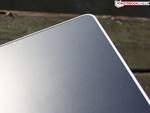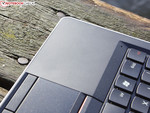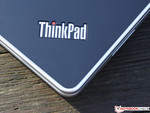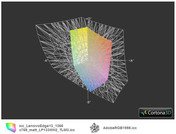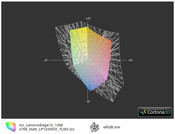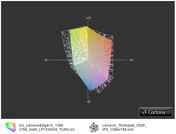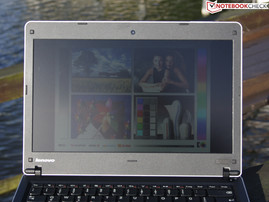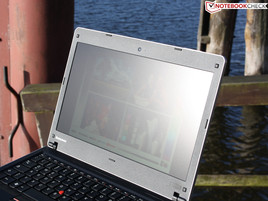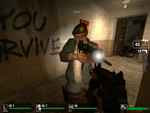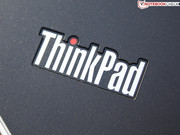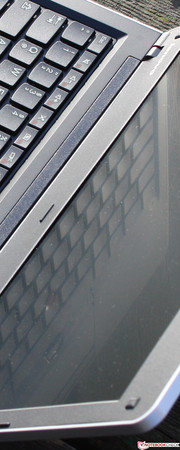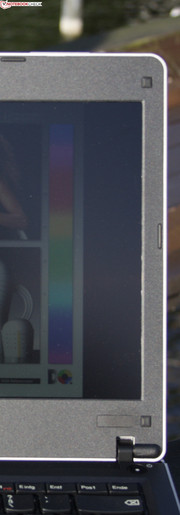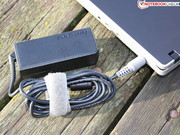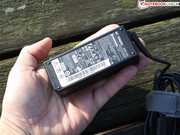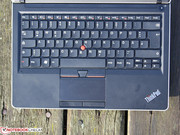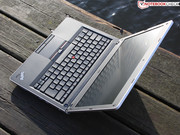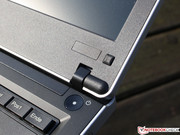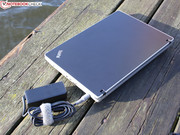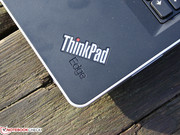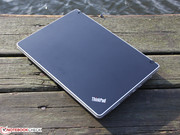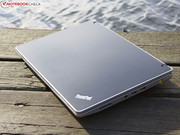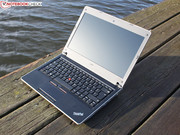Review Lenovo ThinkPad Edge 13 (K685) Subnotebook

The ThinkPad Edge series consists of the cheapest ThinkPad models. Our 13.3 inch test model is available for as little as 399 Euros (without an operating system). The hardware may not be high-end but users who are looking for a matt display and first-class input devices will not be disappointed.
Last March (2010), we wrote an in-depth review on the first Edge 13. At that time, the test model had a glossy display and lacked an eSata port. Since then, the manufacturer has also replaced the AMD Turion X2 Neo K625 or L625 (1.5/1.6 GHz) CPU with a Neo K685 (1.80 GHz). The hard disk capacity has increased from 320 to 500 GB. In short: the latest Edge 13 comes with a few new features. So what should buyers expect?
The test model we picked was the cheapest available as it did not include an OS. As the input devices and the connectivity of the device have remained more or less the same, with the exception of the eSata interface, we will not discuss them at length in this review. In the following review we will concentrate on the new features the Edge 13 (NUE2UGE) has to offer.
Case
ThinkPad Edge laptops are known for their conservative exterior, minimalistic design and matt surfaces. These business laptops remind the user of their larger (and more expensive) ThinkPad brothers due to the similar design.
Our test model boasts a stylish label with the inscription "Black Smooth", which indicates the smooth hand-rest and cover surfaces which are comfortable to touch, yet resistant. In our opinion, the rubber coating on the surface is a good feature as it prevents scratches and fingerprints. The metal display hinges are a nice bonus feature. They hold the display well (up to 185 degrees) and give a long-lasting impression.
The hand-rest region and the display cover are both adorned by the accustomed ThinkPad logo. The dot in the 'i" of the ThinkPad logo on the back lights up, adding a little style to the otherwise conservative design. The dot blinks slowly in standby mode, indicating that the computer is still active. The sturdiness of the case is very good for its price class. The missing optical drive only serves to strengthen the chassis, as usually laptops without an optical drive are sturdier.
Our test model brings 1775 grams to the scale: identical to its predecessor from 2010. Thankfully, the power adapter has slimmed down from 350 to 237 grams. The battery capacity is still the same 63 Wh. The weight of the test model is relatively low for a 13.3 inch model. Most 13 inch laptops, like the IdeaPad Z370, weigh around 2000 grams. The Acer Aspire 3750 is the heaviest model of this category with 2100 grams and Toshiba Portege R830 is the lightest with 1500 grams.
Connectivity
The ThinkPad Edge has good connectivity. On the left side, the notebook offers a fast e-SATA interface which is combined with the third USB 2.0 port. A USB 3.0 port would have crowned the connectivity, however, that port is not (yet) available for notebooks of this price class.
The user will not be able to add extra ports as there is no ExpressCard slot. The placing of a few ports on the back of the device would have been better, but the battery hinders that. The power outlet and the USB 2.0 ports are placed far back on the right side, which means that the respective cables can be wound around the back of the laptop to prevent a clutter.
Display
Sadly, the anti-glare panel from LG-Phillips (Type LP133WH2-TLM3) is nothing exceptional. The display has a 16:9 format and a native resolution of 1.366x768 pixels, which is standard for this form factor. The low contrast of 151:1 is also typical for subnotebooks. The displayed colors are not very strong, and the black areas of the screen seem to have a slight gray sheen.
The low contrast is not due to the matt display of the laptop. A glare type display would show stronger colors but the black value would remain the same. Our first Edge 13 (glare-type) also had a low contrast (164:1). The color space of the panel does not include the sRGB space, which means that it can not display the colors of that spectrum. However, this feature is only important to professional picture editors.
| |||||||||||||||||||||||||
Brightness Distribution: 85 %
Center on Battery: 153 cd/m²
Contrast: 151:1 (Black: 1.36 cd/m²)
37.25% AdobeRGB 1998 (Argyll 3D)
53.2% sRGB (Argyll 3D)
35.9% Display P3 (Argyll 3D)
The matt panel is not very bright. On average, we measured 194 cd/m² with the power adapter connected. Our measurement device recorded a maximum brightness level of 207 cd/m² in the top middle region of the screen. However, as soon as the power adapter is disconnected the laptop dims the screen down to 153 cd/m² (in the middle). For outdoors use, the subnotebook would have been better off with a constant brightness level above 230 cd/m².
The horizontal viewing angles are very small. The colors remained clear up to 40 degrees horizontally, without any sign of inverting. The writing on the screen remains legible vertically up to 50 degrees. However, the brightness starts falling starting at 25 degrees and colors start inverting till they can no longer be recognized.
Performance
The new ThinkPad Edge 13 still uses an AMD Turion Neo X2. However, this time, instead of the L625 (1.6 GHz, TDP 18 W), the laptop is equipped with the K685 (1.8 GHz, TDP 15 W). The difference is in the specifications of the processor, as the latest processor is a Turion II, which means that it has a form factor of 45 nm (Geneva) instead of the old 65 nm (Congo). That is the reason why despite the higher clock frequency, the power consumption of the new CPU is lower.
The Level 1 cache has doubled (K685: 256 KB), and the Level 2 cache has stayed the same (1024 KB). The Geneva platform supports the faster DDR3 RAM (Congo could only support DDR2) via an integrated controller in the CPU.
The ATI Radeon HD 4225 graphic unit (IGP) is responsible for displaying the graphics on the laptop (Congo platform: HD 3200). The unit runs at a core frequency of 382 MHz, and memory is stored on the main RAM modules (up to 256 MB). The playback and decoding of HD videos is supported by the UVD 2 video decoder. The GPU is DirectX 10.1 ready but is too weak to run latest games. More details on the GPU can be found here.
Was the upgrade from the AMD Congo platform to the Geneva platform worth it? As the L625 (1.6 GHz) processor from the first Edge 13 is no longer available on the market, we used the K625 (1.5 GHz) and the E-350 (1.6 GHz) for our benchmarks. These AMD CPUs lie in the same price range of 330 to 420 Euros. Another alternative, the L325 (1.5 GHz), has not yet been tested by us.
The CPU Multi-Core test Cinebench R11.5 showed an end score of 1.0 points. The K625 (0.9) and the E-350 (0.6) are beaten by the result. The Intel alternative (i3 380UM - 2.1 GHz) also scores 1.0 (Sony Vaio VPC-YA1V9E/B) or 1.1 points (Lenovo ThinkPad Edge 11 NVY3PPB), but costs 100 Euros more. Other CPU benchmarks such as wPrime 2.0 (small results are better!) and Cinebench R10 Multi 64 Bit confirm the previous result: K625 (1.657/3.327), E-350 (2.200/2.250), 380UM (1.329/4.266). Our K685 reached 1.410/3.839 seconds/points. So among the AMD CPUs, the K685 (our test model) is number one. However, the Intel CPU processes slightly faster.
Can the Intel CPU stay on top in other system benchmarks which also include the HDD, RAM, GPU support? PCMark Vantage calculated a score of 3,753 points for our test model. This is the same score as the Edge 11 which has an i3 380UM and Intel HD Graphics (3,623 points). The AMD alternatives: K625 (3,017; Dell Inspiron M301z) and E-350 (2,293; HP Pavilion dm1-3180eg) are left far behind.
The new PCMark 7 provided a result of 1,235 points. The Edge 11 based on the E-350 (APU) manages to score 1,101 points. The reason for the small difference: PCMark 7 gives a higher score for better hardware support, which in this case is due to the HD 6310 (80 pipelines instead of 40, DirectX 11 instead of 10.1). That is why the HD 4225 got a lower score in this benchmark. Unfortunately, we do not have the results for the 380UM.
The fact that an i3 380UM Edge 13 is faster does not surprise us. Buyers would be picking the slowest Edge 13 laptop if they picked the brand-new E-350 APU. The better 3D performance of the HD 6310 in the APU will not be enough for most users who will have to deal with longer waiting times and weaker system performance. We recommend the buyer pick the K685 CPU, even if it costs a few more Euros.
| PCMark Vantage Result | 3753 points | |
| PCMark 7 Score | 1235 points | |
Help | ||
In the 3DMark2006 our test model managed to score 1,220 points. The Radeon HD 4225 lies clearly under the HD 6310 (3,588, Acer Aspire 5253) or the GeForce 9400M GeForceBoost (Ion2, 4.075). 3DMark 11 and Unigine Heaven could not be run due to lack of DX 11 support.
Our Edge 13 test model could not even hold its own against HD netbooks. The AMD-based Aspire One 521 (1,046), Asus Eee PC 1015PN (1,155), Asus Eee PC 1015B (C-50, 1,411) and Aspire One 722 (C-50, 1,460) rarely score better than notebooks.
The HD 4225 scored a mere 2.1 points in the OpenGL test of the Cinebench R11.5. To date, most E-350 systems tested by us scored much higher: around 7.5 points. So buyers who want to profit from the 80 shaders in the HD 6310 should pick the Edge 13 E325 model.
| 3DMark 05 Standard | 2753 points | |
| 3DMark 06 Standard Score | 1220 points | |
Help | ||
The fast Hitachi hard disk (500GB, 7200 rpm) gives really high transfer rates. The HDD score from the PCMark Vantage was 3,647 points - an acceptable value for a 7200 rpm hard disk. HD-Tune (84 MB/s read rate) and Crystal Disk Mark 3.0 (113 MB/s read rate) show that the hard disk has very high read rates. Users who want even better performance should add a SSD to the device. With an SSD, speeds of 150 to 700 MB/s (only in RAID 0) can be reached. For example, see Schenker XMG A701 Advanced. The hard disk does not have an activity LED.
Gaming with the Radeon HD 4225
The HD 4225 is not meant for gaming. Our test run with Left4Dead confirmed this suspicion. The hunt for zombies is only fun at the lowest resolution of 640x480 pixels (low details). The game is relatively fluid and runs at 34 fps. The native resolution of (1.366x768 pixels) can not even be picked, and for good reason too. The laptop is already at its limits with a resolution of 1.024x768 pixels and high details. The frames break down and this adversely affects the aiming (13 fps).
We have not yet tested Left4Dead 2 with the E-350, but according to many accounts in different magazines the game should run well with medium details and a resolution of 1366x768 pixels. The better 3DMark results from this system further support those accounts. Any user who wants to use the Edge 13 for serious gaming, should pick the Fusion E-350 device (Edge E325). That model has enough performance to run older games such as Call of Duty 4 with low details. However, due to the fact that the CPU is weaker, the gaming performance may not always be the best possible.
| Left 4 Dead | |||
| Resolution | Settings | Value | |
| 1024x768 | very high, 0xAA, 0xAF | 13.1 fps | |
| 640x480 | min, 0xAA, 0xAF | 33.7 fps | |
| low | med. | high | ultra | |
|---|---|---|---|---|
| Left 4 Dead (2008) | 33.7 | 13.1 |
Emissions
Noise Emissions
The noise emissions of the laptop remain low. The 13.3 inch test model remained quiet at a constant 33 dB(A) while it was idle. The cooler fan never switched off. The hard disk emits far less noise than the cooling system, which means that it is not audible. When we pushed the processor and the graphic unit to their limits simultaneously (stress test), the cooling system turned up to a loud 40 dB(A). When we ran only the 3DMark 2006, the Edge 13 remained at 36.6 dB(A).
Noise level
| Idle |
| 32.7 / 32.8 / 33.7 dB(A) |
| HDD |
| 32.2 dB(A) |
| Load |
| 36.6 / 40 dB(A) |
 | ||
30 dB silent 40 dB(A) audible 50 dB(A) loud |
||
min: | ||
Temperature
The user should have no complaints about the temperature emissions of the laptop. When the laptop is idle or being used for Office purposes, the surface warm up slightly (ranging from 30 to 37 degrees depending on the area). The bottom quickly warms up to 40 degrees, even with very little load. The temperature emissions reached a maximum of 48/47 degrees (top/bottom) during the stress test.
(-) The maximum temperature on the upper side is 46.6 °C / 116 F, compared to the average of 35.9 °C / 97 F, ranging from 21.4 to 59 °C for the class Subnotebook.
(-) The bottom heats up to a maximum of 48 °C / 118 F, compared to the average of 39.3 °C / 103 F
(±) In idle usage, the average temperature for the upper side is 32.8 °C / 91 F, compared to the device average of 30.8 °C / 87 F.
(±) The palmrests and touchpad can get very hot to the touch with a maximum of 37.1 °C / 98.8 F.
(-) The average temperature of the palmrest area of similar devices was 28.2 °C / 82.8 F (-8.9 °C / -16 F).
Speakers
The two speakers can be found under the front of the 13 inch device. The sound output lacks depth as in all notebooks, and middle and highs sound washed-out. The small speakers can not produce clear output at maximum volume. Overall, the sound output is not great, and users will want to use headphones instead of the integrated speakers.
Battery Life
The idle power consumption is higher than that of most Intel Core 13 inch laptops which offer much more performance. First the numbers: in idle mode, the laptop consumes between 13 W (energy saving, low brightness, CPU at 800MHz) and 20 W (maximum performance, highest brightness and CPU at 1800MHz). An Aspire 3750 (i3 2310M, HD 3000) is satisfied with 8 to 11 watts and a Toshiba Portege R830 (identical) requires between 8 to 12 watts.
In the stress test, the power consumption rises further. The 3DMark2006 required 27 W. With the K685 processor, the laptop consumed 40 W. The compact 65 watt power adapter (237 grams) is well-dimensioned. In comparison to other Intel devices, the test model has relatively high idle power consumption, and very slight difference between idle and load power consumption. Intel devices score with a better performance thanks to the Turbo Boost feature.
| Off / Standby | |
| Idle | |
| Load |
|
Key:
min: | |
The battery life of 5 hours and 30 minutes is good for a subnotebook. In our WLAN test (surfing on the web) the laptop lasted 5 hours and 31 minutes, while in a stress test the battery ran for 2 hours and 15 minutes. In comparison: the Core i3 13.3 inch Aspire 3750 lasted just as long in the WLAN test and its battery capacity is identical to that of our test model (63 Wh, 5800mAh). A Toshiba Portege R830-110 can last up to 6 hours due to its larger battery capacity of 66 Wh (WLAN-Test). In short: the test model can last as long as an Intel Core i3 subnotebook as long as the load remains low (i.e. Office use). The brightness of the TFT was set to 100 cd/m² for the WLAN test. To recharge the battery completely the user will need to wait around 2 hours and 30 minutes.
Verdict
The cheap 13.3 inch Lenovo ThinkPad Edge 13 (665D817 - under 400 Euros) offers a few special features which are usually not found in notebooks of this price class. The laptop has first-class input devices (touchpad, trackpoint, keyboard). The sturdiness of the chassis is great and the massive metal hinges support the display very well.
The 500 GB HDD and the eSATA port (combined with a USB 2.0) are also good features. A docking port interface, as found in the bigger ThinkPads, is not present in our test model. The matt display prevents distracting reflections. However, the poor brightness falls even further when the laptop is running on battery: 153 cd/m² in the middle region of the display. This prevents easy outdoors use. The battery life lies around 5 hours and 30 minutes (WLAN surfing) which is quite good.
The performance is modest, and the fast 7200 rpm hard disk adds a few extra points to it. The program performance lies around the same level as a "Low Voltage" Core i5 470UM (Lenovo IdeaPad U260) and clearly above an Intel Atom Dual Core, to be exact, an APU C-50 / E-350 system (ThinkPad Edge E325).
The driver installation was hard as Lenovo did not provide any CDs with the laptop. There is also no collective driver package which is designed for this model. All the drivers can be found on the manufacturer's support website. However, the buyer may get confused as he might not know whether he needs the Intel or the Realtek-WLAN driver, which will lead to an annoying period of trial and error.
A ThinkPad Edge 13 is currently available for as little as 333 Euros (without OS). Buyers should be careful as this might be the older Neo K625 1.50GHz version (658D842) with a glare type panel and no eSATA. Our test model with the Neo K685 1.80GHz is available starting from 399 Euros (without OS) and it is, in our opinion, the better package.




